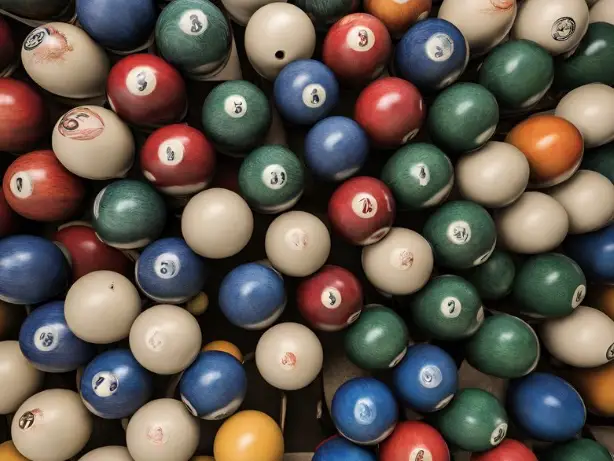Is Duckpin Bowling Popular? Facts About US Participation
While duckpin bowling is not as popular as traditional ten-pin bowling, it has a dedicated following in certain regions of the United States, particularly in the Northeast.
According to a search result from Funk Bowling, duckpin bowling is gaining popularity around the world, with five key reasons cited for its appeal.
These reasons include the unique challenge of the smaller pins and balls, the social aspect of the game, the nostalgia factor, the accessibility for all ages and skill levels, and the fact that it’s a great activity for groups.
Duckpin bowling is a variation of traditional ten-pin bowling that originated in Baltimore, Maryland in the early 1900s. Unlike ten-pin bowling, duckpin bowling uses smaller pins and balls, making it a bit more challenging to knock down all the pins in one throw.
History and Origins
Duckpin bowling is a unique variation of ten-pin bowling that has been around for over a century. The origins of this sport have been disputed, but it is commonly believed to have started in Baltimore, Maryland, around 1900. A bowling, billiards, and pool hall owned by future baseball Hall of Famers John McGraw and Wilbert Robinson, both of the old (1882-1899) Baltimore Orioles, is said to have played a significant role in the development of duckpin bowling.
Development of Duckpin Bowling
The development of duckpin bowling is attributed to the need for a bowling game that was more challenging than ten-pin bowling. Duckpin bowling is played with a smaller ball and pins, making it more difficult to get a strike or a spare. The pins are 9.4 inches tall, and the ball is a maximum of 5 inches in diameter and 3 pounds 12 ounces in weight, with no finger holes. Three balls may be rolled in each frame of the 10-frame game.
Influential Figures
John McGraw and Wilbert Robinson, who owned the bowling, billiards, and pool hall in Baltimore, are often credited with the development of duckpin bowling. However, other influential figures played a significant role in the sport’s growth and popularity. In the early 1900s, the Boston Daily Globe published articles about duckpin bowling, which helped spread the word about the sport beyond Baltimore.
Today, duckpin bowling is enjoyed by many people in the United States, particularly in the Northeast and Mid-Atlantic regions. While it may not be as popular as ten-pin bowling, it has a dedicated following of enthusiasts who appreciate the challenge and unique aspects of the sport.
Playing Duckpin Bowling
Duckpin bowling is a fun variation of standard ten-pin bowling that is most popular in the northeastern United States. If you’re new to duckpin bowling, here is what you need to know before you hit the lanes.
Rules and Scoring
Duckpin bowling has rules similar to ten-pin bowling. The game is played in ten frames, and the object is to knock down as many pins as possible with each roll. A strike is when you knock down all ten pins on your first roll, and a spare is when you knock down all ten pins on your second roll. The maximum score for a single frame is 30, which is achieved by rolling three consecutive strikes.
Equipment and Lane Specifications
The equipment used in duckpin bowling is slightly different from that used in ten-pin bowling. The balls used in duckpin bowling are smaller and do not have finger holes. The pins are also smaller and squatter than those used in ten-pin bowling. The lanes are the same width as those used in ten-pin bowling but are shorter, and the gutters are wider.
The scoring system in duckpin bowling is also slightly different. Each pin knocked down is worth one point, and any pins knocked down on a spare are worth the same as the number of pins knocked down on the first roll of the next frame.
For example, if you knock down eight pins on your first roll of frame one and then two pins on your second roll, you will have a spare. If you then knock down six pins on your first roll of frame two, you will get eight points for the spare in frame one plus six points for the six pins knocked down in frame two, for a total of 14 points.
Overall, duckpin bowling is a fun and challenging game that is enjoyed by people of all ages and skill levels. Whether you’re a seasoned pro or a first-time bowler, you’re sure to have a great time playing duckpin bowling.
Cultural Impact and Popularity
Duckpin bowling is a popular sport in the northeastern United States, particularly in Connecticut, Massachusetts, Indiana, Alabama, Nebraska, and Virginia. It has a regional appeal and is often associated with the East Coast. Duckpin bowling alleys and businesses are dedicated to this sport, and it has a large following of players and enthusiasts who appreciate its unique challenges and historic roots.
Regional Appeal
Duckpin bowling has a strong regional appeal in the northeastern United States, where it remains most popular. It has been played for roughly a century, and there is a large competitive network of duckpin bowlers. The National Duckpin Bowling Congress is the governing body of this sport, and it organizes tournaments and championships for players.
Comparison with Other Bowling Types
Duckpin bowling is different from ten-pin bowling and candlepin bowling. The pins and balls used in duckpin bowling are smaller and lighter compared to ten-pin bowling. The pins are shorter, squatter, and cylindrical in shape, measuring about 9.4 inches (24 cm) tall. In contrast, ten-pin bowling uses taller, narrower pins that stand at a height of 15 inches (38 cm) and have a more tapered shape. Candlepin bowling uses thinner pins and a smaller ball than ten-pin bowling.
While duckpin bowling is not as well-known as ten-pin bowling, it has a dedicated following of players and enthusiasts who appreciate its unique challenges and historic roots. Its impact on American recreational culture is significant, particularly in the northeastern United States, where it remains most popular.
Modern Duckpin Bowling
Duckpin bowling has been around for over a century, but it has evolved with the times. Modern duckpin bowling has seen technological advancements, changes in the community, and an increase in tournaments and competitions.
Technological Advancements
One of the most significant changes in modern duckpin bowling is the technological advancements in equipment. The pinsetter, for example, has been updated to be more efficient and reliable. The use of automatic scoring systems has also become more widespread, making it easier for bowlers to keep track of their scores accurately.
Community and Tournaments
Duckpin bowling has always had a strong sense of community, and this has only grown in recent years. Tournaments and competitions are now more common than ever, bringing together bowlers from all over the country. Ken Sherman, owner of Atomic Bowl in Baltimore, has been instrumental in promoting the sport and organizing tournaments.
The Baltimore Orioles have also been involved in promoting duckpin bowling. The team has hosted a charity tournament for several years, which has helped to raise awareness of the sport and support local charities.
Overall, modern duckpin bowling has seen significant changes in recent years. With technological advancements and an increase in tournaments and competitions, the sport is more popular than ever.
Whether you’re a seasoned pro or a beginner, duckpin bowling is a fun and challenging sport that anyone can enjoy. So grab your duckpin balls and bowling shoes and head to your local bowling center to join in on the fun!




